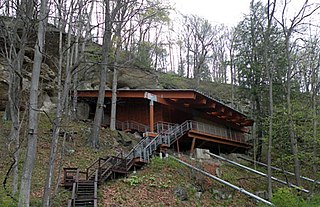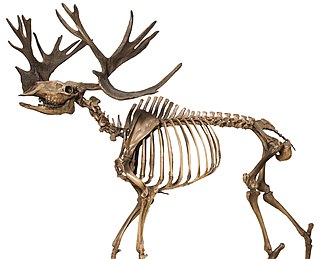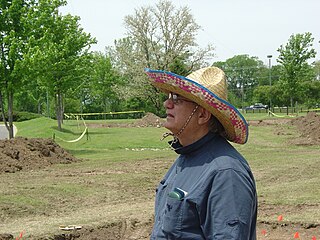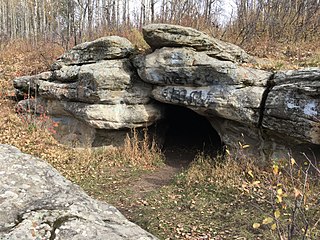
Paleo-Indians were the first peoples who entered and subsequently inhabited the Americas towards the end of the Late Pleistocene period. The prefix paleo- comes from the Ancient Greek adjective: παλαιός, romanized: palaiós, lit. 'old; ancient'. The term Paleo-Indians applies specifically to the lithic period in the Western Hemisphere and is distinct from the term Paleolithic.

Castoroides, or the giant beaver, is an extinct genus of enormous, bear-sized beavers that lived in North America during the Pleistocene. Two species are currently recognized, C. dilophidus in the Southeastern United States and C. ohioensis in most of North America. C. leiseyorum was previously described from the Irvingtonian age but is now regarded as an invalid name. All specimens previously described as C. leiseyorum are considered to belong to C. dilophidus.

Lubbock Lake Landmark, also known as Lubbock Lake Site, is an important archeological site and natural history preserve in the city of Lubbock, Texas, United States. The protected state and federal landmark is 336 acres (136 ha). There is evidence of ancient people and extinct animals at Lubbock Lake Landmark. It has evidence of nearly 12,000 years of use by ancient cultures on the Llano Estacado. It is part of the Museum of Texas Tech University.
The Buhl Woman was an Paleoindian Indigenous American woman whose remains were found in a quarry near Buhl, Idaho, United States, in January 1989. The remains are thought to have been deliberately buried. Radiocarbon dating has placed the age of the skeleton at 12,740–12,420 calibrated years before present, making her remains some of the oldest in the Americas, though the quality of the dating has been questioned.

The Meadowcroft Rockshelter is an archaeological site which is located near Avella in Jefferson Township, Pennsylvania. The site is a rock shelter in a bluff overlooking Cross Creek, and contains evidence that the area may have been continually inhabited for more than 19,000 years. If accurately dated, it would be one of the earliest known sites with evidence of a human presence and continuous human occupation in the New World.
The Page–Ladson archaeological and paleontological site (8JE591) is a deep sinkhole in the bed of the karstic Aucilla River that has stratified deposits of late Pleistocene and early Holocene animal bones and human artifacts. The site was the first pre-Clovis site discovered in southeastern North America; radiocarbon evidence suggests that the site dates from 14,200 to 14,550 BP. These dates are roughly 1,000 to 1,500 years before the advent of the Clovis culture. Early dates for Page–Ladson challenge theories that humans quickly decimated large game populations in the area once they arrived.

The Stanfield-Worley Bluff Shelter, located on private property in Colbert County in northwestern Alabama, United States, is one of the most important prehistoric sites excavated in the state due to the archeological evidence deposited by the Paleo-Indians who once occupied the rock shelter. Lying in Sanderson Cove along a tributary of Cane Creek approximately seven miles (11 km) south of the Tennessee Valley, the shelter and the high bluffs of the surrounding valley provided a well-protected environment for the Native American occupants.

Cervalces scotti, also known as stag-moose, is an extinct species of large deer that lived in North America during the Late Pleistocene epoch. It is the only known North American member of the genus Cervalces. Its closest living relative is the modern moose.

The Thunderbird Archaeological District, near Limeton, Virginia, is an archaeological district described as consisting of "three sites—Thunderbird Site, the Fifty Site, and the Fifty Bog—which provide a stratified cultural sequence spanning Paleo-Indian cultures through the end of Early Archaic times with scattered evidence of later occupation."

Cueva Fell or Fell'sCave is a natural cave and archaeological site in southern Patagonia. Cueva Fell is in proximity to the Pali Aike Crater, another significant archaeological site. Cueva Fell combined with the nearby Pali Aike site have been submitted to UNESCO as a possible World Heritage Site.

Prehistory of Ohio provides an overview of the activities that occurred prior to Ohio's recorded history. The ancient hunters, Paleo-Indians, descended from humans that crossed the Bering Strait. There is evidence of Paleo-Indians in Ohio, who were hunter-gatherers that ranged widely over land to hunt large game. For instance, mastodon bones were found at the Burning Tree Mastodon site that showed that it had been butchered. Clovis points have been found that indicate interaction with other groups and hunted large game. The Paleo Crossing site and Nobles Pond site provide evidence that groups interacted with one another. The Paleo-Indian's diet included fish, small game, and nuts and berries that gathered. They lived in simple shelters made of wood and bark or hides. Canoes were created by digging out trees with granite axes.
The Coats–Hines–Litchy site is a paleontological site located in Williamson County, Tennessee, in the Southeastern United States. The site was formerly believed to be archaeological, and identified as one of only a very few locations in Eastern North America containing evidence of Paleoindian hunting of late Pleistocene proboscideans. Excavations at the site have yielded portions of four mastodon skeletons, including portions of one previously described as being in direct association with Paleoindian stone tools. The results of excavations have been published in Tennessee Conservationist, and the scholarly journals Current Research in the Pleistocene, Tennessee Archaeology, and Quaternary Science Reviews. The site was listed on the National Register of Historic Places on July 12, 2011.

Platygonus compressus, the flat-headed peccary, is an extinct mammal species from the Tayassuidae family that lived in North and South America during the Pleistocene. It was first described in 1848 by John L. Leconte.

John Bertram Broster is an American archaeologist formerly serving as the Prehistoric Archeological Supervisor at the Tennessee Division of Archaeology, Department of Environment and Conservation. He is best known for his work on the Paleoindian period of the American Southwest and Southeast, and has published some 38 book chapters and journal articles on the subject.
The Anzick site (24PA506), located adjacent to Flathead Creek, a tributary of the Shields River in Wilsall, Park County, Montana, United States, is the only known Clovis burial site in the New World. The term "Clovis" is used by archaeologists to define one of the New World's earliest hunter-gatherer cultures and is named after the site near Clovis, New Mexico, where human artifacts were found associated with the procurement and processing of mammoth and other large and small fauna.

The Charlie Lake Cave (Tse'KWa) is an archaeological site in the Canadian province of British Columbia. Its Borden System designation is HbRf 39. In a waste pit in front of the small cave, artifacts up to 10,500 years old have been found which are considered to be the oldest evidence of ritual acts in Canada. The cave is located a few kilometers north of Fort St. John, near Charlie Lake.

Paleo Crossing site, also known as the Old Dague Farm site, is an archaeological site near Sharon Center, Ohio in Medina County where Clovis artifacts dated to 10,980 BP ± 75 years Before Present were found. The Cleveland Museum of Natural History conducted an excavation from 1990 to 1993. The site provides evidence of Paleo-Indians in northern Ohio and may be the area's oldest residents and archaeologist Dr. David Brose believes that they may be "some of the oldest certain examples of human activity in the New World." The site contains charcoal recovered from refuse pits. There were also two post holes and blades and tools 80% of which were made from flint from the Ohio River Valley in Indiana, 500 miles from Paleo Crossing, which indicates that the hunter-gatherers had a widespread social network and traveled across distances relatively quickly. The post holes are evidence that there was a shelter built on the site.
The Yana Rhinoceros Horn Site is an Upper Palaeolithic archaeological site located near the lower Yana river in northeastern Siberia, Russia, north of the Arctic Circle in the far west of Beringia. It was discovered in 2001, after thawing and erosion exposed animal bones and artifacts. The site features a well-preserved cultural layer due to the cold conditions, and includes hundreds of animal bones and ivory pieces and numerous artifacts, which are indicative of sustained settlement and a relatively high level of technological development. With an estimated age of around 32,000 calibrated years before present, the site provides the earliest archaeological evidence for human settlement in this region, or anywhere north of the Arctic Circle, where people survived extreme conditions and hunted a wide range of fauna before the onset of the Last Glacial Maximum. The Yana site is perhaps the earliest unambiguous evidence of mammoth hunting by humans.

Cooper's Ferry is an archaeological site along the lower Salmon River near the confluence with Rock Creek in the western part of the U.S. state of Idaho, and part of the Lower Salmon River Archeological District. It is 17 kilometres (11 mi) south of the town of Cottonwood and 63 kilometres (39 mi) upstream from the Snake River. Various lithic and animal remains from the Pleistocene to early Holocene ages have been found there. The site is on traditional Nez Perce land, and known to the tribe as the historical village of Nipéhe.

Daisy Cave, also known as CA-SMI-261, is an archeological site located on San Miguel Island in California. San Miguel Island is the westernmost island in the Channel Islands. The island sits between the Santa Barbara Channel and the Pacific Ocean and is often notably battered by winds all year round, but the Daisy Cave itself provides solace from the weather and has served as an effective shelter time and time again. The cave appears to have multiple archaeological deposits, in which artifacts ranging from the "terminal Pleistocene to the present." San Miguel was once part of a larger 'Superisland,' connected with Santa Rosa, Santa Cruz and Anacapa to make up Santarosae. Santarosae existed as the 'superisland' until as recent as 10,000 years ago, with some estimation.

















